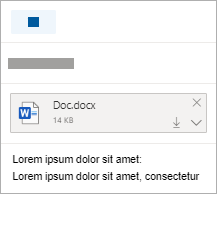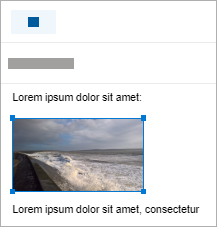Add pictures or attach files to email messages in Outlook
It's easy to attach pictures, files, and other items to your Outlook messages. Outlook keeps track of the documents you’ve recently worked on, whether they're stored on your computer or saved in OneDrive (cloud only). And no matter where they're stored, Outlook lets you quickly choose whether to send the document as a traditional attachment or upload it to OneDrive and share a link to the file. You can also set permissions on any file sent from OneDrive that allow message recipients to view and edit them or share them with others.
Select a tab option below for the version of Outlook you're using. What version of Outlook do I have?
Note: If the steps under this New Outlook tab don't work, you may not be using new Outlook for Windows yet. Select Classic Outlook and follow those steps instead.
In Outlook, you have the option to:
Attach a file | Upload a locally saved file to your OneDrive | Insert a picture into the body of a message | Attach an email item | Solve problems with attachments
Attach a file to an email message in new Outlook
New Outlook keeps track of the files you have worked on recently and suggests them whenever you decide you want to attach a file to an email message. Some file types are blocked from being sent or received. See Blocked attachments in Outlook for the complete list.
-
In a new message, a reply, or a forwarding message, select Attach File from the Insert group on the Message tab.
Tip: You'll only see Insert group on the ribbon when you select New mail, or after you select Reply, Reply all, or Forward on a received message.
-
Select your file from one of the following locations:
-
Suggested files
The three most recent cloud files you've worked on will be displayed here. These files may be on OneDrive, SharePoint, or another online document library. Select a file to attach to your email. -
OneDrive
Locations include OneDrive, SharePoint sites, or connected third-party cloud storage providers. Select one of the locations to open a new window and then select your attachment. -
Browse
This Computer Opens a File Explorer window where you can choose a file from your computer.
-
-
If you select a file on your local computer or group document library, a copy of the file is attached to the email. Selecting a OneDrive or SharePoint file, however, provides you with additional permission options and information.
-
Send a link or send a copy: Sending a link to the OneDrive or SharePoint file keeps the size of your email message small. If you choose to send a copy of the file, the entire file is attached to the email, just like it would be if you selected a file on your computer. If you choose to send a link to the file, you can also set the permissions on your file.
-
By default, if you're in a business environment, everyone within your organization can edit the linked file. To change these permissions, select the arrow at the right of the attachment name to display a drop-down menu with a variety of permission options.
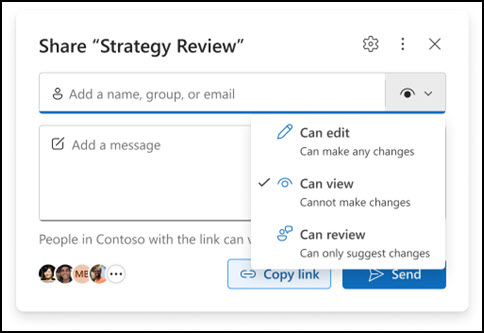
-
Organization can Edit: if you want anyone in your organization to be able to modify the file. They will also be allowed to share the item with others.
-
Organization can View: if you want anyone in your organization to be able to read, but not modify, the file. They will not be allowed to share the item with others.
-
Recipients can Edit: if you want only the recipients of your email to be able to modify the file. They will also be allowed to share the item with others.
-
Recipients can View: if you want only the recipients of your email to be able to read, but not modify, the file. They won't be able to edit or share the file with others.
To learn more, visit Sharing files, folders, and list items.
-
-
If new Outlook detects that your recipients won't be able to view the file, for example, if it's stored on a SharePoint site that's only accessible to you, you'll see the link highlighted in red with a warning icon next to it. Select Manage access to resolve the warning message. You can also manage permissions by selecting the arrow.
Note: If you attach a file as a copy, any changes your recipient makes won't be synchronized with the version of the file in OneDrive or on SharePoint.
Warning about forgotten attachments
If you mention an attachment in your email message but don’t include it before sending the message, new Outlook will display a warning about the forgotten attachment. You can then decide to add an attachment or send the message without one.
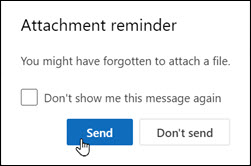
This feature is available only for email text which is formatted in English (US) and is independent of the language used for new Outlook. For example, if you use a Spanish version of new Outlook and the proofing tools for English (US), you can create an email message with text formatted in English (US). If you mention an attachment in this message but don’t attach one, new Outlook will display a warning about the forgotten attachment.
Upload a locally saved file to your OneDrive from new Outlook
When you attach a document that is saved on your computer and not in an online location, you also can choose to upload the document to your OneDrive before sending the email. Uploading the attachment makes collaboration easy. You can be sure that everyone is collaborating on the same (and most up-to-date) version of the file. You may also choose to upload to OneDrive if the file is too large to share as a traditional attachment.
-
On the ribbon, select Attach File, then Browse This PC, and choose the file you want to attach.
-
In your email message, select the down arrow for the attachment.
-
Choose Upload to OneDrive, and then choose the desired location for the file.
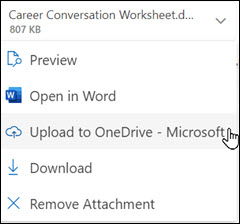
Note: You might see choices such as the OneDrive location for your work account, the OneDrive location for your personal account, and document libraries for various groups you belong to.
-
The file will then appear as a friendly link. Right-click on the friendly link if you want to attach as a copy, edit permissions, or change to full URL.
-
To change these permissions, select the arrow at the right of the attachment name to display a drop-down menu with a variety of permission options.
To learn more, visit Sharing files, folders, and list items.
Insert a picture into the body of an email message in new Outlook
When sending pictures, you can either attach the picture to the email message or insert the picture in the message body. To insert a picture that displays in the body of an email message, use the following steps:
-
Position your cursor where you want the image in your message.
-
In the ribbon, select Insert, then Pictures.
-
Browse your computer or online file locations for the picture you want to insert. Select the picture, then select Open.
-
To resize the picture, drag the handles at one of the four corners toward the center of the image or away from the center.
Note: For more information about resizing pictures in Outlook, see Reduce the size of pictures and attachments in Outlook email messages
Attach an email item to an email message in new Outlook
Attaching calendar information to an email is not supported in the new Outlook for Windows. You can share or publish your calendar, or you can create a scheduling poll for easier scheduling of meetings.
Note: To share contacts, you will have to export them to .csv files and attach them as a file.
Solve problems with attachments for new Outlook
-
Why can't I attach a file? Outlook tells me the file is unsafe. New Outlook blocks numerous file types that have the potential to spread computer viruses. To send a file that new Outlook identifies as unsafe, zip the file first, then attach the zipped file. To zip a file, navigate to the folder on your computer or in the cloud that contains the file, right-click the file, and select Send to compressed (zipped) folder. You should then be able to send the zipped file. For more information, see Blocked attachments in Outlook.
-
Why do my attachments show up in the message body and not below the subject line? New Outlook allows you to send email messages in three formats: HTML, plain text, and rich text. If you use rich text format (RTF), any files you attach will show up in the message body. See Change your message format for instructions on how to switch your message format to HTML or plain text. You can check your message format by looking at the title bar of the message.
-
Why do my friendly links show up as a copy?
Friendly links are only for HTML formatted emails. If you attempt to upload an attachment to Rich Text or Plain Text, it will add as a copy. If you use Rich Text format (RTF), any files you attach will show up as a copy in the message body. If you use Plain Text, any files you attach will show up below the subject line. -
The Insert > Pictures option is grayed out. If you can't select Pictures from the Insert tab on the ribbon, your message is probably in plain text format. Change your message format to HTML or rich text to insert pictures. You can check your message format by looking at the title bar of the message.
In Outlook, you have the option to:
Attach a file | Upload a locally saved file to your OneDrive | Insert a picture into the body of a message | Attach an email item | Solve problems with attachments
Attach a file to an email message in classic Outlook
Outlook keeps track of the files you have worked on recently and suggests them whenever you decide you want to attach a file to an email message. Some file types are blocked from being sent or received. See Blocked attachments in Outlook for the complete list.
-
In a new message, a reply, or a forwarding message, select Attach File from the Include group on the Message tab.
Tip: You'll only see Include on the ribbon when you select New mail, or after you select Reply, Reply all, or Forward on a received message.
-
Select your file from one of the following locations:
-
Recent items
The 12 most recent files you've worked on will be displayed here. These files may be on your computer, on OneDrive, SharePoint, or another online document library. Select a file to attach it to your email. -
Browse Web Locations
Locations include OneDrive, SharePoint sites, or other locations such as a groups document library that you've accessed before. Select one of the locations to open a new window and then select your attachment. -
Attach Item
Gives you the option to include a Business Card or Outlook item. -
Browse This PC
Opens a File Explorer window where you can choose a file from your computer.
-
-
If you selected a file on your local computer or group document library, a copy of the file is attached to the email. Selecting a OneDrive or SharePoint file, however, provides you with additional permission options and information.
-
Send a link or send a copy Sending a link to the OneDrive or SharePoint file keeps the size of your email message small. If you choose to send a copy of the file, the entire file is attached to the email, just like it would be if you selected a file on your computer. If you choose to send a link to the file, you can also set the permissions on your file.
-
By default, if you're in a business environment, everyone within your organization can edit the linked file. To change these permissions, select the arrow at the right of the attachment name to display a drop-down menu with a variety of permission options.
-
Organization can Edit if you want anyone in your organization to be able to modify the file.
-
Organization can View, if you want anyone in your organization to be able to read, but not modify, the file.
-
Recipients can Edit if you want only the recipients of your email to be able to modify the file.
-
Recipients can View if you want only the recipients of your email to be able to read, but not modify, the file.
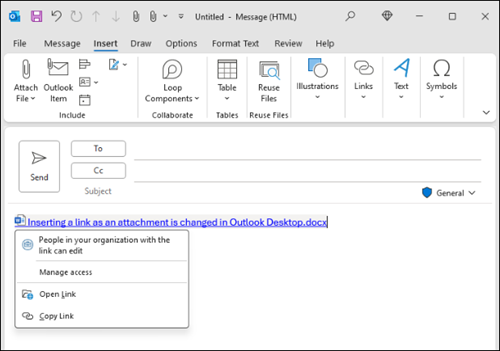
-
-
If Outlook detects that your recipients won't be able to view the file, for example if it's stored on a SharePoint site that's only accessible to you, you'll see a warning message directly under the file icon and name. Select Attach as copy to change the attachment from a linked file to a copy of the file.
Note: If you attach a file as a copy, any changes your recipient makes won't be synchronized with the version of the file in OneDrive or on SharePoint.
Warning about forgotten attachments
If you mention an attachment in your email message but don’t include it before sending the message, Outlook will display a warning about the forgotten attachment. You can then decide to add an attachment or send the message without one.
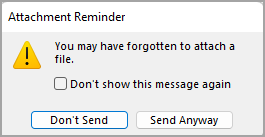
This feature is available only for email text which is formatted in English (US) and is independent of the language used for Outlook. For example, if you use a Spanish version of Outlook and the proofing tools for English (US), you can create an email message with text formatted in English (US). If you mention an attachment in this message but don’t attach one, Outlook will display a warning about the forgotten attachment.
Upload a locally saved file to your OneDrive from classic Outlook
When you attach a document that is saved on your computer and not in an online location, you also can choose to upload the document to your OneDrive before sending the email. Uploading the attachment makes collaboration easy. You can be sure that everyone is collaborating on the same (and most up-to-date) version of the file. You may also choose to upload to OneDrive if the file is too large to share as a traditional attachment.
-
On the ribbon, click Attach File > Browse This PC, and choose the file you want to attach.
-
In your email message, select the down arrow for the attachment.
-
Choose Upload to OneDrive, and then choose the desired location for the file.
Note: You might see choices such as the OneDrive location for your work account, the OneDrive location for your personal account, and document libraries for various groups you belong to.
-
In your email message, select the down arrow for the attachment again.
-
Choose Change Permissions, and then choose one of the following:
-
Organization can Edit if you want anyone in your organization to be able to modify the file.
-
Organization can View, if you want anyone in your organization to be able to read, but not modify, the file.
-
Recipients can Edit if you want only the recipients of your email to be able to modify the file.
-
Recipients can View if you want only the recipients of your email to be able to read, but not modify, the file.
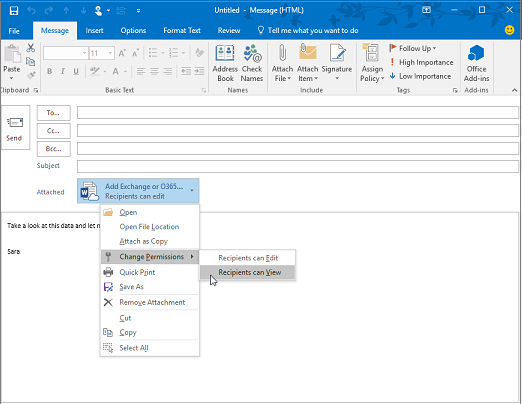
-
Insert a picture into the body of an email message in classic Outlook
When sending pictures, you can either attach the picture to the email message or insert the picture in the message body. To insert a picture that displays in the body of an email message, use the following steps:
-
Position your cursor where you want the image in your message.
-
In the ribbon, select Insert > Pictures.
-
Browse your computer or online file locations for the picture you want to insert. Select the picture, then select Insert.
-
To resize the picture, drag the handles at one of the four corners toward the center of the image or away from the center.
Note: For more information about resizing pictures in Outlook, see Reduce the size of pictures and attachments in Outlook email messages
Attach a business card, a calendar, or other email item to an email message in classic Outlook
-
In a new message, select Attach Item.
-
Choose one of the following:
-
Business Card
Choose an electronic business card from your contacts list. -
Calendar
Choose Date Range, Details, and other options as appropriate. -
Outlook Item
Choose one or more email messages from any of your email folders.
-
-
Select the item you want to attach, and then select Insert.
Solve problems with attachments for classic Outlook
-
Why can't I attach a file? Outlook tells me the file is unsafe. Outlook blocks numerous file types that have the potential to spread computer viruses. To send a file that Outlook identifies as unsafe, zip the file first, then attach the zipped file. To zip a file, navigate to the folder on your computer or in the cloud that contains the file, right-click the file, and select Send to compressed (zipped) folder. You should then be able to send the zipped file. For more information, see Blocked attachments in Outlook.
-
Why do my attachments show up in the message body and not below the subject line? Outlook allows you to send email messages in three formats: HTML, plain text, and rich text. If you use rich text format (RTF), any files you attach will show up in the message body. See Change your message format for instructions on how to switch your message format to HTML or plain text. You can check your message format by looking at the title bar of the message.
-
Why do my inline shared links show up as a copy?
Shared links are only for HTML formatted emails. If you attempt to add a shared link to Rich Text or Plain Text, it will be added as a copy. If you use Rich Text format (RTF), any files that you attach will show up as a copy in the message body. If you use Plain Text, any files that you attach will show up below the subject line. -
The Insert > Pictures option is grayed out. If you can't select Pictures from the Insert tab on the ribbon, your message is probably in plain text format. Change your message format to HTML or rich text to insert pictures. You can check your message format by looking at the title bar of the message.
In Outlook, you have the option to:
Attach a file | Attach a link from OneDrive | Insert a picture into the body of a message | Attach an email item
You can attach photos and documents from your computer or OneDrive to email messages and calendar events. Attachments always appear at the top of the email.
You can also insert pictures anywhere in your messages, so that recipients see the image where you want, and as soon as they open the email. They don't need to be opened to be viewed.
|
Attachments look like this: |
Inserted images look like this: |
|---|---|
|
|
|
Attach a file or picture from your computer in Outlook on the web or Outlook.com
-
Reply, Forward or create a new email message or calendar event.
-
Select

-
Choose the file you want to attach and select Open. To attach more than one file, hold CTRL (or Command in Mac) while selecting multiple files.
Notes:
-
When you attach a file from your computer, you're attaching a copy of the file. Each recipient will get their own copy of the file.
-
You can also drag and drop files from your computer into your message. As you drag them over a new message, a Drop files here hint will appear:

Attach a link to a picture, file or folder from your OneDrive for Outlook on the web or Outlook.com
-
Reply, Forward or create a new email message or calendar event.
-
Select

-
Choose the file from your OneDrive or other cloud storage you want to link to and select Next. To attach more than one file, hold CTRL (or Command in Mac) while selecting multiple files.
-
You can also use Copy link of a OneDrive attachment and paste it elsewhere.
Notes:
-
When you attach a OneDrive link, all recipients can view or edit the same file.
-
If you want to restrict editing, select

-
To add a cloud location such as Box, Dropbox or Google Drive, open your Storage account settings.
Add or insert pictures to an email in Outlook on the web or Outlook.com
Attachments always appear above the body of your message, but you can insert pictures inline anywhere in your message. Inserted images don't need to be downloaded to be seen by the recipient.
-
Reply, Forward or create a new email message or calendar event and position the cursor to where you want to add your pictures
-
Select Insert, then Pictures and choose the file you want to insert and select Open. To insert more than one file, hold CTRL (or Command in Mac) while selecting multiple files.
-
Drag the corner handles to resize the image or right-click the image to see formatting options.
Attach an email in Outlook on the web or Outlook.com
-
Reply, Forward or create a new email message or calendar event.
-
Move it to a new window by selecting Open in new window at the top corner.
-
Arrange the windows so you can see both the message list and your new message side by side.
Tip: Use the Windows key

-
Select the emails you want to attach to your new message.
-
Drag the selected messages from the message list to the body of your new message. As you drag them over the new message, a Drop messages here hint will appear:


